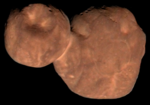 | |
| Discovery | |
|---|---|
| Discovered by | Rafael Luque, Diana Kossakowski |
| Discovery site | TESS |
| Discovery date | 2019 |
| Detection method | Radial velocity |
| Orbital characteristics | |
| Semi-major axis | 0.204±0.015 AU |
| Eccentricity | ≈0.033 ± 0.057 |
| Orbital period (sidereal) | 55.70±0.05 d |
| Inclination | <40° |
| Star | Gliese 357 |
| Physical characteristics | |
| Mass | 6.1±1.0 M🜨 7.20±1.07 M🜨 |
| Temperature | 219.6 ± 5.9 K (−53.55 ± 5.90 °C; −64.39 ± 10.62 °F) |
Gliese 357 d is an exoplanet, considered to be a "Super-Earth" within the circumstellar habitable zone of its parent star. The planet orbits Gliese 357, 31 light-years from the Solar System, The system is part of the Hydra constellation.
The planet was discovered by the TESS team and announced in July 2019. The data confirming the presence of the planet was uncovered in ground-based observation dating back to 1998 while confirming the TESS detection of Gliese 357 b, a “hot earth” that orbits much closer to the parent star. Even though Gliese 357 d is 20% closer to Gliese 357 than Earth is to the Sun, Gliese 357 is much smaller than the Sun. So it receives as much energy as Mars. As a result, it is estimated that the average temperature is -64°F (-53°C), but this temperature is survivable for humans; if there is a thick enough atmosphere, the actual temperature could be much higher. If humans traveled there using modern spacecraft, it would take them about 660,000 years to get there. The planet is 6.1 times more massive than Earth and 2.3 times Earth's size.
Footnotes
- Calculated assuming the spacecraft travels at 14 km/s. For comparison, the New Horizons spacecraft is exiting the solar system at a velocity of 13.7 km/s as of June 2024.
References
- ^ Luque, R.; Pallé, E.; et al. (2019). "Planetary system around the nearby M dwarf GJ 357 including a transiting, hot, Earth-sized planet optimal for atmospheric characterization". Astronomy & Astrophysics. 628: A39. arXiv:1904.12818. Bibcode:2019A&A...628A..39L. doi:10.1051/0004-6361/201935801. ISSN 0004-6361. Archived from the original on 2023-09-24. Retrieved 2020-05-12.
- ^ Jenkins, J S; Pozuelos, F J; et al. (2019). "GJ 357: a low-mass planetary system uncovered by precision radial velocities and dynamical simulations". Monthly Notices of the Royal Astronomical Society. 490 (4): 5585–5595. arXiv:1909.00831. doi:10.1093/mnras/stz2937. ISSN 0035-8711.
- Falconer, Rebecca (2019-08-01). "Newly uncovered super-Earth 31 light-years away may be habitable". Axios. Archived from the original on 2019-12-18. Retrieved 2019-08-04.
- ^ Reddy, Francis; Center, NASA’s Goddard Space Flight (2019-07-31). "TESS Discovers Habitable Zone Planet in GJ 357 System". SciTechDaily. Archived from the original on 2019-08-01. Retrieved 2019-08-01.
- "Potentially habitable 'super-Earth' discovered just 31 light-years away". NBC News. 31 July 2019. Archived from the original on 2019-07-31. Retrieved 2019-08-01.
- ^ Garner, Rob (2019-07-30). "NASA's TESS Helps Find Intriguing New World". NASA. Archived from the original on 2019-08-01. Retrieved 2019-08-01.
- Talbert, Tricia (2021-04-15). "NASA's New Horizons Reaches a Rare Space Milestone". NASA. Archived from the original on August 22, 2022. Retrieved 2021-04-18.
- "plot_GJ_357.png". Planetary Habitability Laboratory. 2019-09-03.
This extrasolar-planet-related article is a stub. You can help Misplaced Pages by expanding it. |


